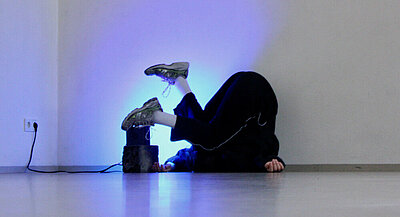Research As An Act Of Resistance
Julia Plawgo was part of the pilot project Berlin Dance Residency Program. Would she recommend continuing it?

In April 2021, Julia Plawgo spent four weeks at ada Studio in the frame of the pilot project Berlin Dance Residency Program funded by the Berlin Senate Department for Culture and Europe. Nine different dance venues hosted the residencies in the last year and a half. While the existing funding structure still doesn’t take into account a large part of the work processes of artists, the residency funding for dance – which addresses in particular pre-conceptual work and research phases – in conjunction with other programs such as Tanzpraxis scholarships closes a funding gap for the almost exclusively freelance Berlin dancers and choreographers. Here’s what Julia Plawgo experienced in the course of her residency. In November, she will present the results in the context of ada Studio’s NAH DRAN extended choreographic series.
Text: Julia Plawgo
Dancer and choreographer
For every dancer/choreographer, research time is an extremely important part of an artistic process. Being able to afford a studio without project funding is not possible for all those that are engaged in producing or participating in dance in Berlin. For me, the opportunity to make use of a whole month of studio time and a stipend that supported me during that time span was a very rare occurence and provided the support needed to advance my artistic research.
Continuing one’s artistic practice
The duration of the residency allows one to experiment as well as to spend time on a work-in-progress for a new production, if desired. Otherwise, it provides enough time to further develop an artistic practice, such as delving deeper into one’s movement research, formulating new questions about one’s work and receiving external support, technical or artistic/dramaturgical.
In times where still the majority of funding possibilities focus on production, it is extremely important to be able to get studio time that’s not necessarily product-oriented. This time is crucial to keep up the continuity of an artistic practice, especially for dance makers who, under normal financial circumstances, are not always able to develop and grow outside of the time spent producing new work. I think the more opportunities there are for choreographers, in terms of financial funding as well as for using spaces for research in a continuous way, the better future productions will be, too. During research time, the practice can be explored on a deeper level and also expand, and there’s enough time to ask oneself questions like: Do I need more time to develop this material? Or: Am I ready to apply for production funding?
Being part of a local context
For me, being able to be on a residency in the city I live in was a great luxury that doesn’t happen very often. Going abroad or to another city is not always possible and sometimes comes with additional obstacles. In my case, the Coronavirus crisis and a previous work engagement wouldn’t allow me to move from Berlin. Being able to stay in the comfort of my own home and commute to the studio every day was very helpful and I am sure that it positively influenced my time of the residency.
Additionally, the incomparable professionalism and care that Gabi Beier from ada Studio provided was another type of strong support I received throughout my residency period. Clear communication, artistic and practical support and always being there to answer possible questions helped me structure my work. Weekly meetings in the studio provided me the opportunity to share my process, exchange ideas and receive feedback. I am very thankful for that.
Digital experience and the body
I personally spent my studio time developing further my research on digital space and the body. Before the residency started I wrote: “I would like to think of this research as an act of resistance against the existing conditions of the world by creating and inhabiting, just like in a video-game, an alternative space conditioned by a separate set of rules. I would also like to think of this research as a way of bringing my generation’s experience of ‘living body-lessly in a digital space’ to the body. I will use dance as a tool that has the potential of generating knowledge to reflect on this experience and try to create a bridge for the gap between my offline and online life.”
Over the course of the four weeks, I managed to develop quite a few movement qualities that best resembled a global but also very personal experience of a more and more digitalized world. I attained a better understanding of what kind of aesthetic I am moving toward. I had enough time to experiment and crystallize some aspects of my movement research. Thanks to that time and especially to that space, I was also able to work with light and props/stage design elements that supported me. I also thoroughly documented my research on video, which will allow me to go back to it when I have the next opportunity to continue my research. Video also became a medium that I not only documented my work with, but also that I had time to explore as a choreographic tool. I will present the results of my residency at ada Studio in the context of NAH DRAN extended: MISSED PIECES II in November.
For me, none of this would have been possible without the Berlin Dance Residency Program. I think it is of the utmost importance to provide as many artists in Berlin as possible with the opportunity to benefit from research residencies like this.
(Edited by Elena Philipp)